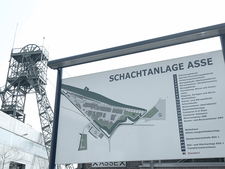In search of the right way
The road to a safe decommissioning concept
Emplacement of radioactive waste in the Asse mine started in 1967. A decommissioning concept for the time following emplacement did not exist at that time, however. Under today's law a licence for a repository would not be granted without a decommissioning concept being available. A decommissioning concept including an analysis of long-term safety previously furnished is a prerequisite for a nuclear licence for a repository – and naturally for its decommissioning, as well. As to the Asse mine, however, the required decommissioning concept and the analysis of long-term safety need to be developed retrospectively, taking into account the now prevailing conditions. Numerous experts are currently dealing with the search for the best solution.
The decommissioning concept of the former operator HMGU

![]() The information panel at the entrance to the premises provides an overview of the buildings at the site.
The information panel at the entrance to the premises provides an overview of the buildings at the site.
The former operator, Helmholtz Zentrum München (HMGU), assumed that the inflow of saline solution, which had been known since 1988, would continue. To stabilise the mine the HMGU chose the option to backfill the mine to a large extent with salt grit and concrete and to flood the residual cavities. A saturated saline solution (protective fluid) which does neither affect the potash (carnallitite) nor the rock salt deposits and which has a higher density than the influent solution, was supposed to have the effect that the influent water could not reach the large areas of potash rock. New cavities would develop otherwise, due to dissolution and reprecipitation. This should be prevented by a protective fluid. Furthermore it was assumed that the protective fluid would also generate a supporting effect in the mine workings, which would slow down the continuing movement of the rock and which would thus reduce the pressing of contaminated solution.
In terms of the flooding concept the HMGU assumed that the Asse II mine would not remain dry over long periods of time due to the damaging of the rock and the waters already flowing into the mine. When flooding the mine, the protective fluid would come into contact with the radioactive waste, so that radioactive material would be removed from the waste.
Furthermore, it was planned to construct so-called flow barriers part of which have already been constructed. The objective was to conduct the solutions in a way that they pass the emplacement chambers. That is how the HMGU wanted to keep the volume of the solution as low as possible, which flows into the chambers where it takes up radioactivity and is then pressed out of the chambers again as a result of the rock movement.
Comparison of Options Working Group
After the former operator's decommissioning concept had come under public criticism, the Federal Ministry of Education and Research, the Federal Environment Ministry and the Lower Saxony Ministry for the Environment and Climate Protection agreed in November 2007 upon examining other decommissioning options, too. For this purpose, the Comparison of Options working group (AGO) was established in March 2008. The BfS did also take part in this working group.
The AGO was to test the HMGU decommissioning concept, to develop measures to improve the mine's stability and to examine possible options for decommissioning. As a basis, external experts conducted studies about the possibility to retrieve the intermediate-level radioactive waste from the 511-m level of the Asse mine and to stabilise the mine. As the first option proposed by the BfS, the AGO approved the backfilling of roof clefts as a reasonable step to increase the mine's stability. This was started in 2009.
Result of the comparison of options
In February 2009, the AGO published a report in which they evaluated what options to close the Asse mine should be investigated in more detail. As a result, the BfS investigated three decommissioning options in a so-called comparison of options with the help of previously established criteria:
- One option was to retrieve the waste from the mine and to store it elsewhere (retrieval).
- Another option called for creating new cavities in a deeper part of the salt dome and relocating the waste to this area (relocation).
- The third option involved the complete backfilling of the cavities in the mine with concrete (complete backfilling).
The result of the evaluation of the three decommissioning options was published by the BfS in January 2010: The prime aim in the decommissioning of Asse is the long-term safety of man and environment. The BfS as the operator of Asse needs to furnish proof that the selected decommissioning option does not put man and environment in the area at risk, not even in the long term. According to the present state of knowledge, this can only be achieved by retrieving the waste from the Asse mine.
Fact-finding
Existing uncertainties and gaps in knowledge need to be eliminated in order to be able to retrieve the stored radioactive waste from the Asse II mine. That is the only way to evaluate the consequences of retrieval properly and to plan the technical implementation in detail. For this purpose two emplacement chambers depicting all storage situations are being investigated. To ensure the safety of man and environment during retrieval as much data as possible needs to be collected beforehand - e.g. about the state of the waste packages, the radioactive exposure of the chamber air and the stability of the emplacement chambers.

